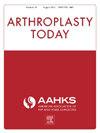采用直接前路全髋关节置换术通过保留髂股内侧韧带减少术后腿长差异
IF 2.1
Q3 ORTHOPEDICS
引用次数: 0
摘要
本研究比较了直接前路全髋关节置换术(THA)中保留髂股内侧韧带和切除髂股内侧韧带的术后腿长差异(LLD)和整体髋关节偏移(GO)。方法回顾性分析2022年1月~ 2024年7月101例单侧全髋关节置换术患者,将患者分为韧带切除组和韧带保留组。髂股内侧韧带于2022年1月至2023年8月切除,并于2023年9月至2024年7月保留。最终腿长是根据术中THA稳定性的确认来确定的。分析术前和术后x线片测量LLD和GO。观察两组患者术后LLD和GO对侧绝对差异(±5mm)的百分比。为了尽量减少植入物的影响,例如大直径头,仅使用直径为28或32 mm的THA头。并观察术后3个月内的临床并发症。结果保存组术后LLD和绝对LLD均明显小于切除组(P <;.01),较少患者出现术后LLD >;5 mm (P <;. 01)。两组间的GO没有差异。临床并发症:切除组脱位1例,骨折2例,感染1例,保留组骨折1例。并发症发生率无明显差异。结论直接前路入路保留髂股内侧韧带可有效减少术后LLD,且不增加并发症或损害GO。本文章由计算机程序翻译,如有差异,请以英文原文为准。
Total Hip Arthroplasty Using a Direct Anterior Approach Reduces Postoperative Leg Length Differences by Preserving the Medial Iliofemoral Ligament
Background
This study compared postoperative leg length discrepancy (LLD) and global hip offset (GO) between medial iliofemoral ligament preservation and excision during total hip arthroplasty (THA) using direct anterior approach.
Methods
A retrospective review of 101 unilateral THA cases performed between January 2022 and July 2024 divided patients into 2 groups: ligament excision and ligament preservation groups. The medial iliofemoral ligament was excised from January 2022 to August 2023 and preserved from September 2023 to July 2024. The final leg length was determined based on intraoperative confirmation of THA stability. Preoperative and postoperative radiographs were analyzed to measure LLD and GO. The percentage of cases with absolute postoperative LLD and GO contralateral differences >5 mm was examined in both groups. To minimize the influence of implants, such as large diameter heads, only THA head diameters of 28 or 32 mm were used. Clinical complications within 3 months postsurgery were also examined.
Results
The preservation group exhibited significantly smaller postoperative LLD and absolute LLD than the excision group (P < .01), with fewer patients experiencing postoperative LLD >5 mm (P < .01). GO did not differ between the groups. Clinical complications included one dislocation, 2 fractures, and one infection in the excision group, while the preservation group had one fracture. No significant difference in complication rates was found.
Conclusions
Medial iliofemoral ligament preservation during THA using direct anterior approach effectively reduces postoperative LLD without increasing complications or compromising GO.
求助全文
通过发布文献求助,成功后即可免费获取论文全文。
去求助
来源期刊

Arthroplasty Today
Medicine-Surgery
CiteScore
2.90
自引率
0.00%
发文量
258
审稿时长
40 weeks
期刊介绍:
Arthroplasty Today is a companion journal to the Journal of Arthroplasty. The journal Arthroplasty Today brings together the clinical and scientific foundations for joint replacement of the hip and knee in an open-access, online format. Arthroplasty Today solicits manuscripts of the highest quality from all areas of scientific endeavor that relate to joint replacement or the treatment of its complications, including those dealing with patient outcomes, economic and policy issues, prosthetic design, biomechanics, biomaterials, and biologic response to arthroplasty. The journal focuses on case reports. It is the purpose of Arthroplasty Today to present material to practicing orthopaedic surgeons that will keep them abreast of developments in the field, prove useful in the care of patients, and aid in understanding the scientific foundation of this subspecialty area of joint replacement. The international members of the Editorial Board provide a worldwide perspective for the journal''s area of interest. Their participation ensures that each issue of Arthroplasty Today provides the reader with timely, peer-reviewed articles of the highest quality.
 求助内容:
求助内容: 应助结果提醒方式:
应助结果提醒方式:


